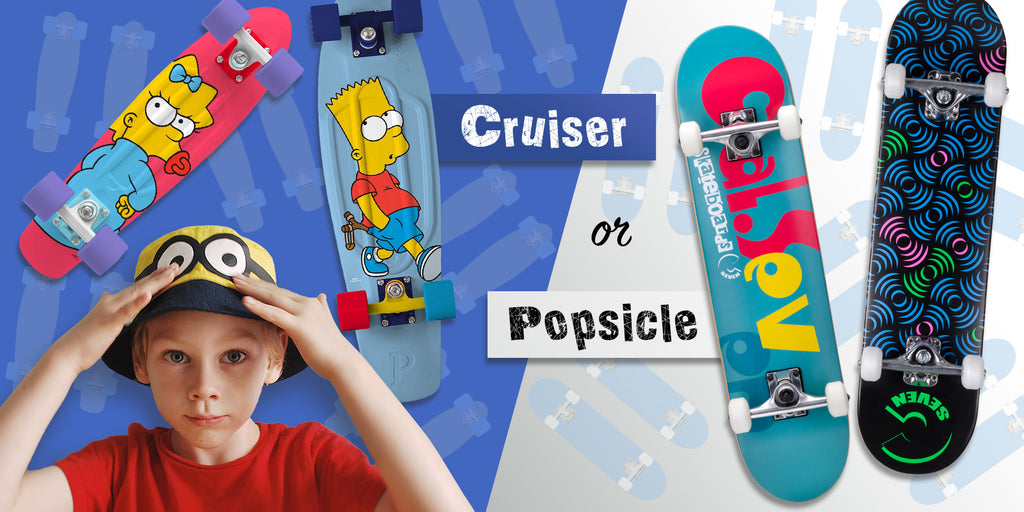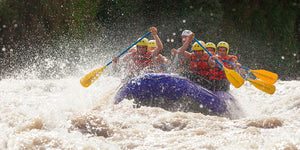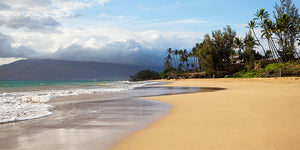Popsicle or Cruiser: Which Skateboard Is Best For Heading Back To Class?

Different skateboards will perform differently, and it can be difficult for non-experts to choose the right one to suit their needs. Ultimately, making the right selection comes down to how you intend to use the board.
A Board That Can Get You There
When stable, comfortable, reliable transportation is your priority, a cruiser will serve you best. Cruisers have soft, chunky wheels that extend beyond the width of the deck for maximum stability and shock absorption. Like the name implies, a cruiser is designed for smooth riding over sidewalk cracks, bumpy asphalt and uneven surfaces. A cruiser won’t come to a screeching halt and throw the rider face first onto the pavement when its front wheels hit a pebble or small twig.
Cruiser decks are available in both wood and plastic. Plastic decks are lightweight, offer shock absorbing flexibility, and come in virtually every color and style you can imagine, including clear and glow in the dark. Wood cruiser decks are sturdier and heavier.
Another advantage of the cruiser is its smaller size compared to a standard board, which makes it easier to strap to a backpack, stow in a locker, or just carry around between rides. A regular cruiser is 27 inches long and 7.5 inches wide. The compact mini-cruiser is usually 22 inches long and just 6 inches wide.
A rider who weighs over 200 lbs., has large feet, or who tends to ride with a heavy backpack will want to go for either a wood cruiser or the larger, 27 inch plastic cruiser. The larger deck can handle more weight, provides more foot space, and will offer more stability for the rider whose loaded backpack can throw things off balance.
A Board For Fun
Maybe a car, bus or train has already got you covered on the transportation front, and you’re looking for a board to pass the time between classes or shifts. For you, a standard popsicle board is the better choice.
Typically about 32 to 34 inches long and 7.5 to 8.5 inches wide, popsicle decks are constructed of multiple plys of Maple wood to handle the forces at work when landing big air tricks or grinding rails. They’re usually slightly concave, to hold the rider’s stance steady, and will typically offer a kicktail at both ends to maximize trick possibilities.
The wheels are small and hard, and don’t extend beyond the sides of the board. These qualities make it easier to pivot, spin or flip the board, either on the ground or in the air, without catching on the rider’s feet or clothes, and make it possible to slide at an angle over short distances.
Best of Both Worlds
Those who want to combine the smooth ride of a cruiser with the trick and stunt capabilities of a standard board can buy a popsicle board and replace its wheels with something a little larger and softer than the wheels that came with the board, but a little smaller and harder than the typical cruiser wheel.
The usual popsicle board wheel runs from 97A to 100A on the durometer (hardness) scale, will measure about 50 to 60mm in diameter, and have a width, or contact patch, from 30 to 40mm. A typical cruiser wheel will have a durometer rating from 70A to 78A, a diameter of at least 60mm and width between 50 and 60mm.
For the most versatile ride, swap out the wheels that came with your board for something in the 80 to 90 durometer range with a diameter measurement of 60 to 70mm and a width measurement of 40 to 50mm. Be sure to add the appropriate riser pad as well, since a larger wheel will need more clearance to avoid wheel bite.
Whatever your needs or style, there’s a skateboard to keep you cruising, carving, grinding or catching air all year long.
- Outdoors Staff






Comments 0